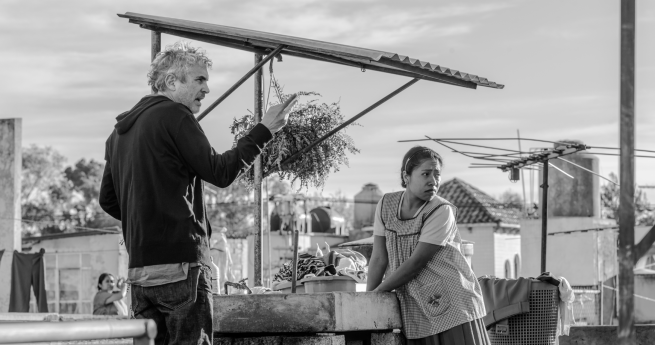Directed by Alfonso Cuaron

Roma is breathtaking and incredibly moving, not just from an emotional standpoint but because of the grace with which it is constructed. It’s a deeply intimate story shot in the manner of an epic, something Cuaron is well adept at doing following movies like Children of Men (2007) and Gravity (2013). The smallest moments, brought to the big screen, are made larger than life, and really all I’m trying to say is that Roma is one of the best movies I have ever seen.
The story follows Cleo (Yalitza Aparicio), a maid and all around rockstar for an upper class family in Mexico City. She cares for the family’s gaggle of children and endures the occasionally pointed words of her employer, Sofia, who is acting out after her husband left her for another woman.
Cleo’s journey, from the outside, is quiet and heartbreaking, following about a year in her life after her impregnation by a boy she barely knows (and who abandons her). Cuaron, acting as his own director of photography, shoots the film almost entirely in wide shots, which either remain motionless or pan softly to the left and right.
Like with his other films he makes great use of the long take. Two scenes in particular, one involving child birth and the other traversing into thrashing waves, stand out and are deceptively long. In the former the camera remains mostly still while the emotional-taxing action plays out in several planes of the frame. The latter has the camera move a few dozen meters left and right on a beach, ultimately working its way into chest high waters.
Much of the film features dynamic background action. Many scenes play out in relative silence while something amazing goes on in the background. Sometimes it’s just a marching band or a martial arts class, and in another it’s a large-scale riot. Cuaron doesn’t call too much attention to all this action, but neither does he cheat it. He shoots in a manner so that you know it’s really happening then and there.
For these reasons Roma, again like Children of Men, is insanely immersive. The sound design too, I should mention, is wild, and in a theater the noises travel throughout the audience, and in some cases make you think a person beside you is talking.
It’s hard not to feel what it’s like to live in this time and place. Every image is a visual masterpiece, and the choreographed action feels so organic that it’s hard not to feel like you’re standing right there. Where some productions may carefully differentiate between foreground and background action, in Roma it’s often melted together. There are moments of no great importance, conventionally speaking, in which characters move between the front and back of the screen, covering a lot of space. It’s hard not to wonder how many takes some of these scenes took, like one in which the father of Cleo’s child threatens her and then hurries off to board a moving truck deep in the back of the frame.
I think a lot of the timing works, or seems to, because from what I can tell there wasn’t a rigid script (within the confines of a given shot) to work from. Many of the actors are nonprofessional, and Cuaron apparently would only give them certain dialogue on the day of. My guess is that it kept the actors enough on their toes that a particular moment might only borrow some of the scripted dialogue. That means that when the father of Cleo’s child had to run off to the truck, he reacted to it in real time, as you do in life.
Such a naturalistic way of shooting would seem to allow for the freedom of movement within the frame. Just about every shot, including the first, of Roma is riveting. The whole thing feels fluid and authentic, and then you have the heartbreaking story underneath. This isn’t just a well-shot melodrama but a well-shot, well-scripted and well-acted human story. The whole thing is quite the experience, one of the best I’ve had at the theater all year.
Up Next: The Favourite (2018), Terminator 3: Rise of the Machines (2003), The Right Stuff (1983)
